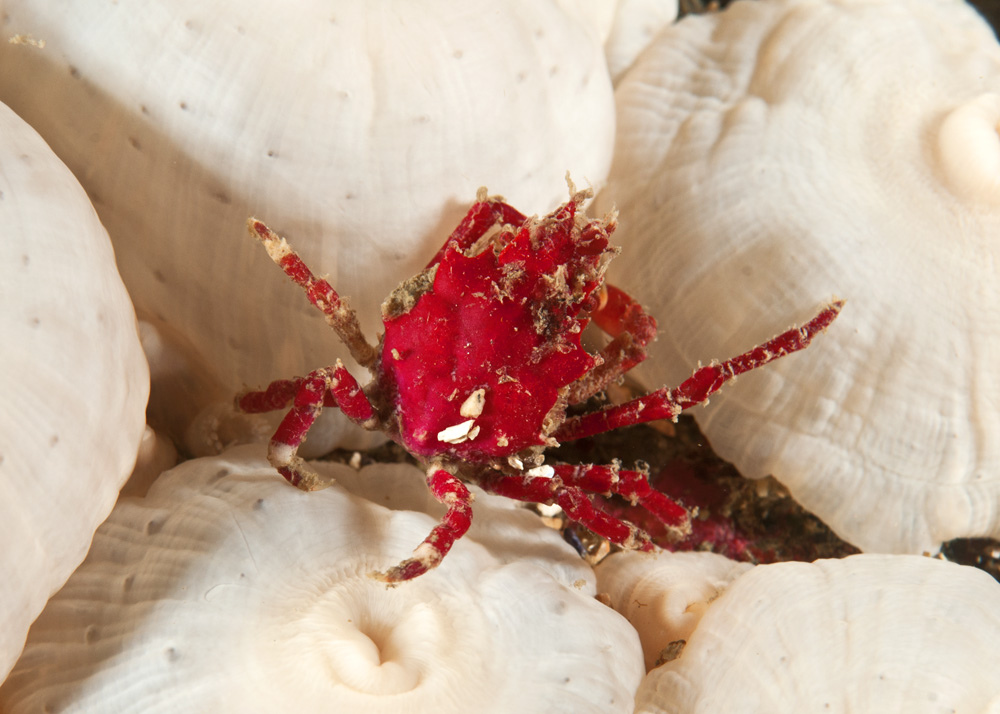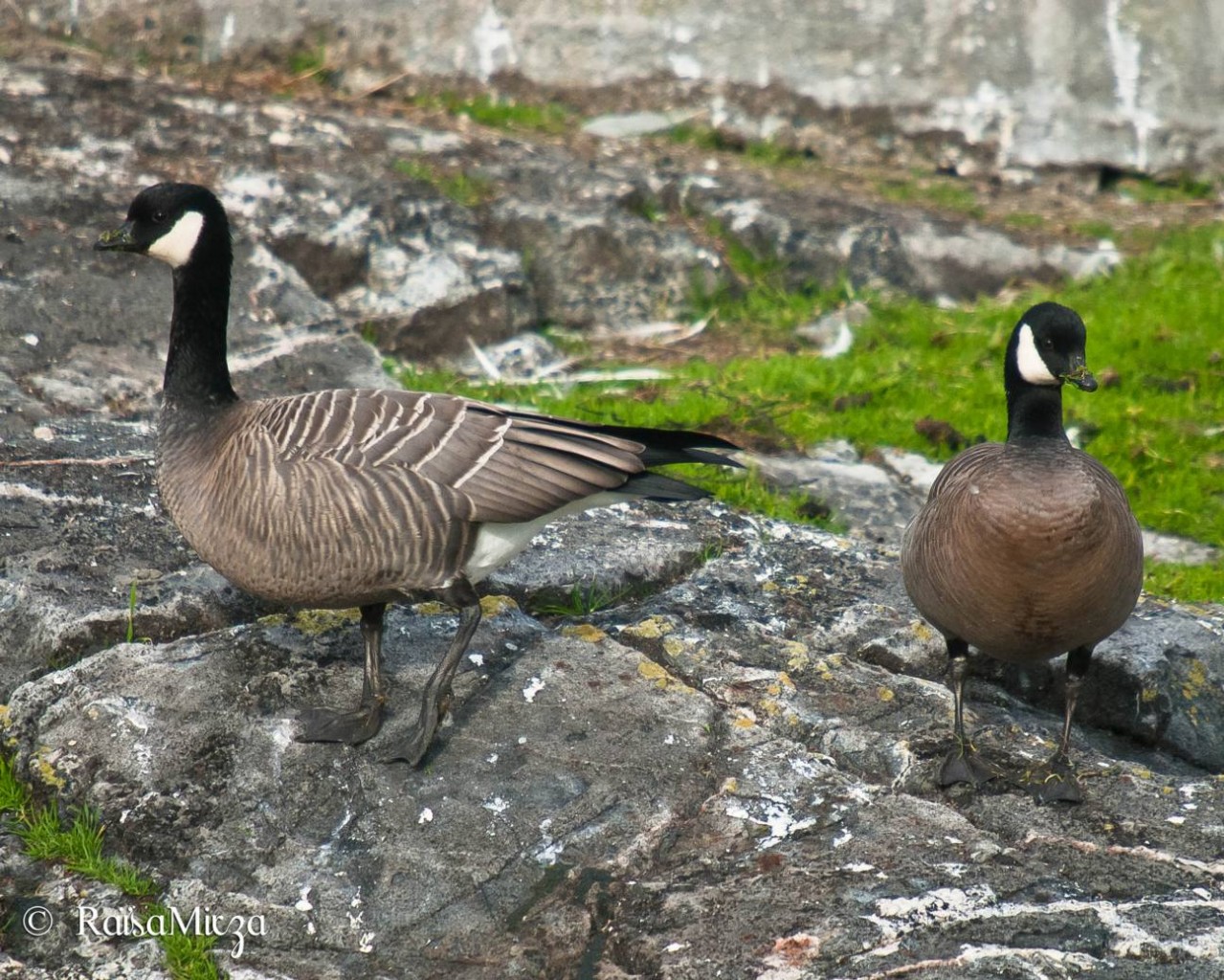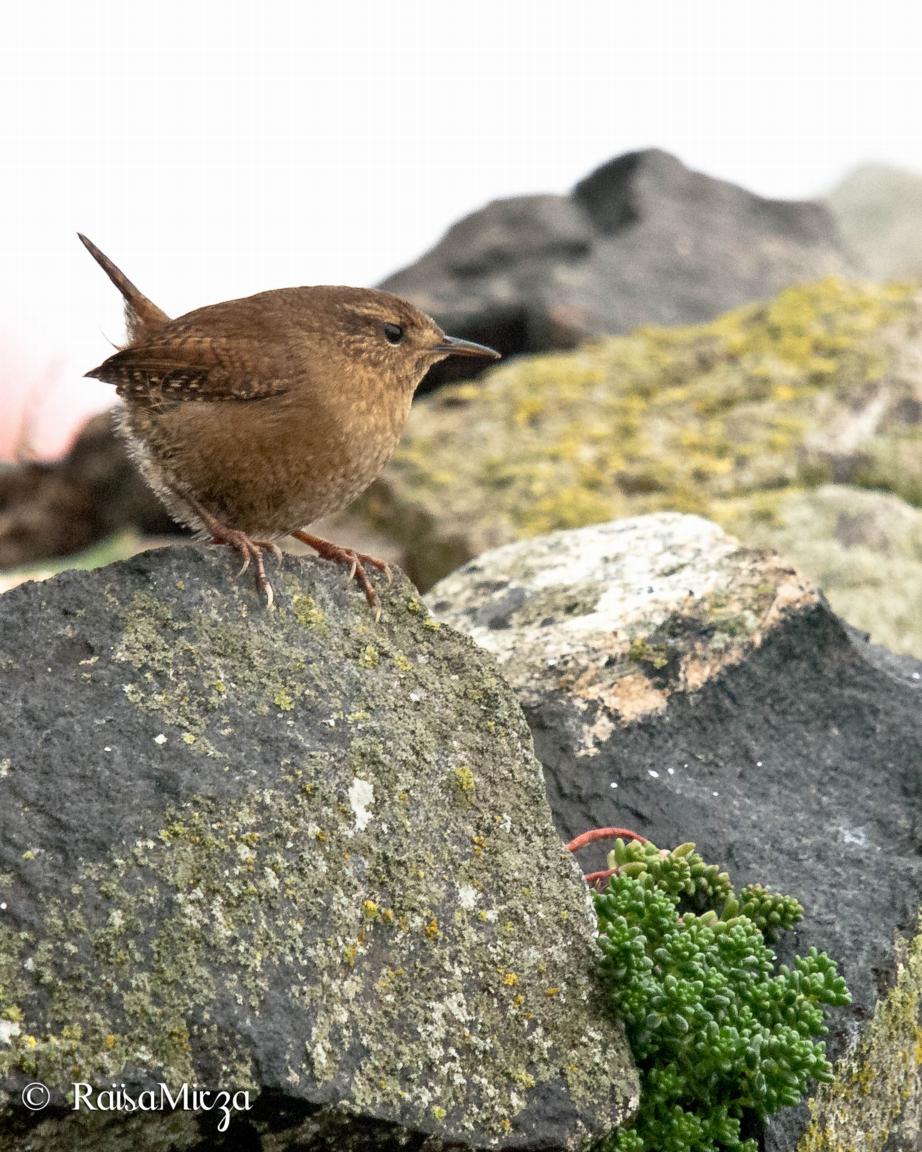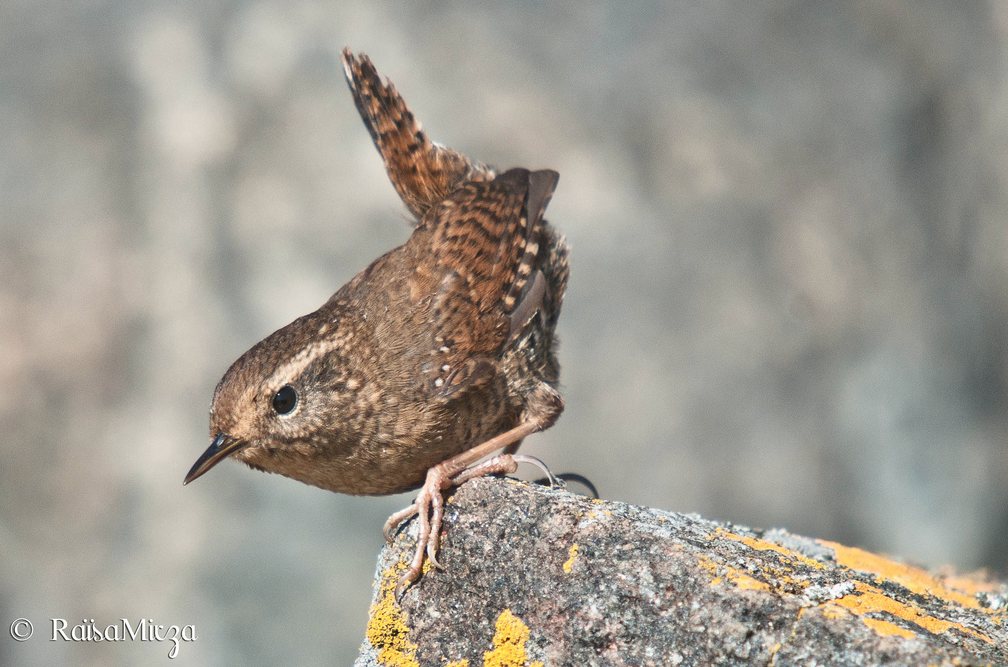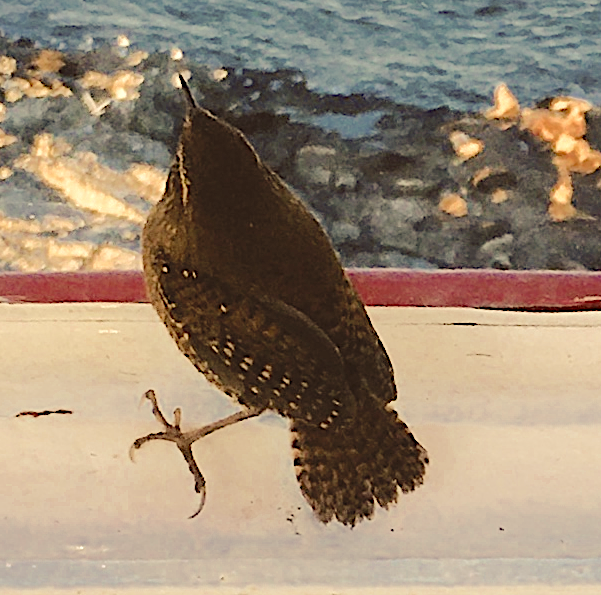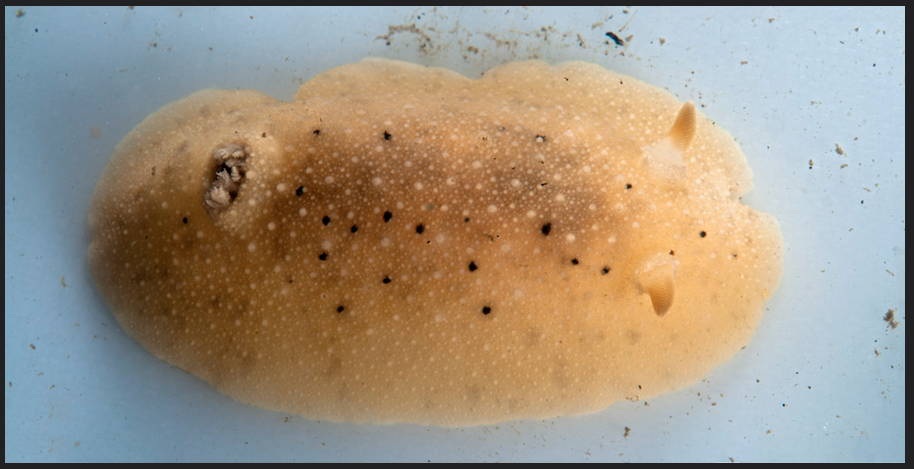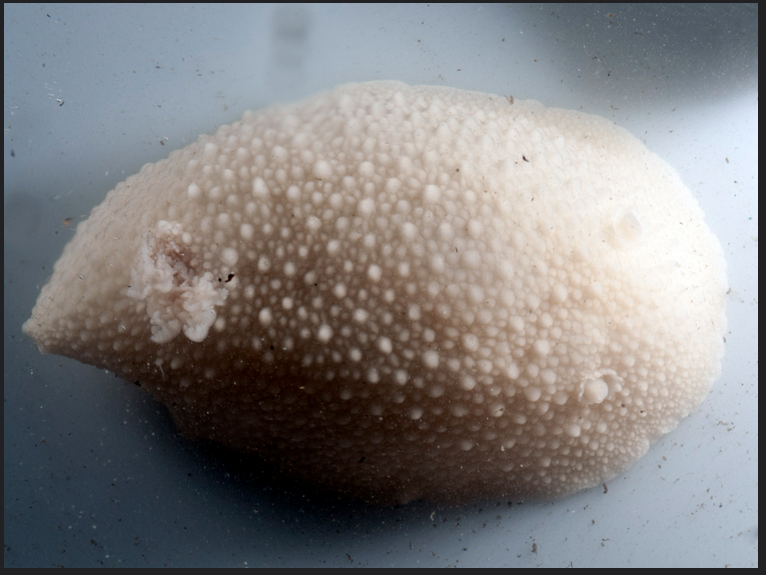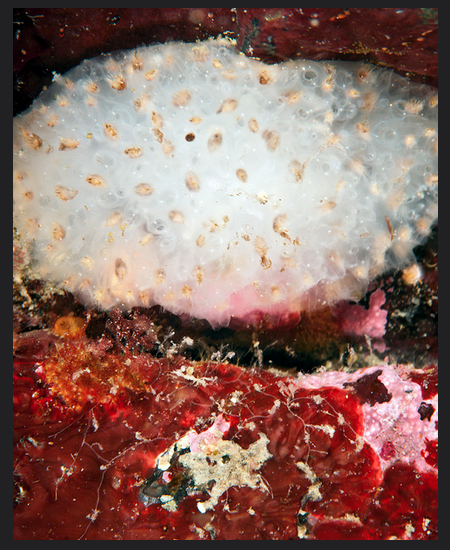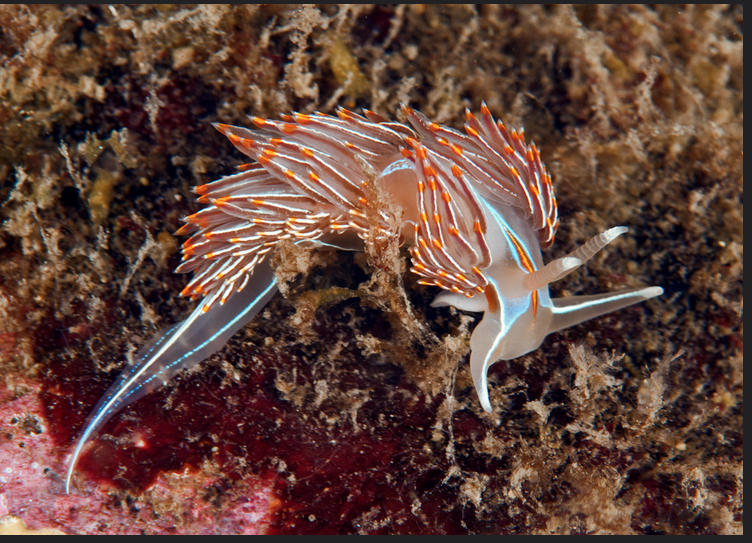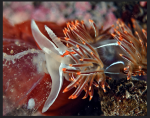‘2010-10-31’, ‘California Sea Lion’, 10, ”, ‘Ryan’, ’12:22:06 ,
‘2010-10-31’, ‘Northern Sea Lion’, 100, ”, ‘Ryan’, ’12:22:36 ,
‘2010-10-31’, ‘Other’, 5, ‘White-fronted Geese’, ‘Ryan’, ’12:23:28 ,
Monthly Archives: October 2010
Rock greenling sighted by divers
‘I was really excited to see a Rock Greenling on one of the dives today. The students and I were making a wide counter-clockwise drift dive around Great Race Rock and in the surf-grass bed on the W side of the island a beautiful Rock Greenling was spotted. It was a very curious fish, leaving its position to check out each diver individually before returning to the grass.’, ‘Ryan’, ’13:11:06 ,
Pugettia gracilis: Graceful kelp crab–The Race Rocks Taxonomy
We see this small crab occasionally at Race Rocks. Ryan caught this one as it nestled in between white anemone.
Scientific classification
Kingdom: Animalia
Phylum: Arthropoda
Subphylum: Crustacea
Class: Malacostraca
Order: Decapoda
Infraorder: Brachyura
Family: Epialtidae
Genus: Pugettia
Species: P. gracilis
Other Members of the Phylum Arthropoda at Race Rocks.
and Image File |
 The Race Rocks taxonomy is a collaborative venture originally started with the Biology and Environmental Systems students of Lester Pearson College UWC. It now also has contributions added by Faculty, Staff, Volunteers and Observers on the remote control webcams. The Race Rocks taxonomy is a collaborative venture originally started with the Biology and Environmental Systems students of Lester Pearson College UWC. It now also has contributions added by Faculty, Staff, Volunteers and Observers on the remote control webcams. |
Cackling Goose, Branta hutchinsii—Race Rocks Taxonomy
Domain |
Eukarya |
Kingdom |
Animalia |
Phylum |
Chordata |
Subphylum |
Vertebrata |
Class |
Aves |
Order |
Anseriformes |
Family |
Anatidae |
Subfamily |
Anserinae |
Genus |
Branta |
Species |
hutchinsii |
Common Name: |
Cackling Goose |
This is the first observation and photos we have of cackling geese at Race Rocks. Ecoguardian Raisa Mirza took this photo on October 22, 2010. These geese migrate south through the area at this time of year. This is a newly recognized and smaller species of the Canada Goose. Recent work on mitochondrial DNA genetic differences found the four smallest forms to be very different. These four races are now recognized as a full species: the Cackling Goose. It breeds farther northward and westward than does the Canada Goose..Fall migration includes staging on the upper Alaska Peninsula for several weeks, then a trans-oceanic flight to Oregon and California.
This tag will bring up other examples of observations of this species at Race Rocks.
Troglodytes pacificus: Pacific wren-The Race Rocks Taxonomy
Our first sighting of Troglodytes pacificus-( Pacific wren) was made today. This very small bird is making use of the old rock walls leading up to the foundation for the original lightkeeper’s house at the base of the tower.
- Pacific Wren ,November 10, 2010. The winter wren overwinters in Southern British Columbia as well as points south, It is often seen foraging along shorefronts between logs and in the brush and grasses around estuarine areas.
- Raisa took this image on May 1, 2011 and she commented on her Flickr site: “I know there is a Pacific wren (Troglodytes pacificus) that lives on Race Rocks. He is so small though that I’m never sure where he will pop up so its always a surprise when I see him. This time, he came to say hello, he was quite close by (he is smaller than a cupful of one hand) and posed for me for a few minutes before flying off. I tried looking for him but with so many crevices and places to hide- it is quite impossible. Until next time when he decides he wants to be seen!”
Domain Eukarya
Kingdom Animalia
Phylum Chordata
Sub-Phylum Vertebrata
Class Aves
Order Charadriiformes
Family Troglodytidae
Genus Troglodytes
Species pacificus
Common Name: Pacific wren
More observations of the Pacific wren on racerocks.com
The wren was also observed in the tower in October 2019
Other Members of the Class Aves at Race Rocks.
and Image File |
 The Race Rocks taxonomy is a collaborative venture originally started with the Biology and Environmental Systems students of Lester Pearson College UWC. It now also has contributions added by Faculty, Staff, Volunteers and Observers on the remote control webcams. The Race Rocks taxonomy is a collaborative venture originally started with the Biology and Environmental Systems students of Lester Pearson College UWC. It now also has contributions added by Faculty, Staff, Volunteers and Observers on the remote control webcams. |
Humpback whale at Race Rocks
Raisa Mirza took some images today of a humpback whale off Race Rocks.
Geitidoris heathi : (Heath’s dorid)– The Race Rocks Taxonomy
Kingdom: Animalia
Phylum: Mollusca
Class: Gastropoda
Order: Opisthobranchia
Suborder: Nudibranchia
Superfamily: Doridoidea
Family: Discodorididae
Genus: Geitodoris
Species: G. heathi
Geitodoris heathi (MacFarland, 1905)
Synonyms Discodoris heathi
Other Members of the Phylum Mollusca at Race Rocks.
and Image File |
 The Race Rocks taxonomy is a collaborative venture originally started with the Biology and Environmental Systems students of Lester Pearson College UWC. It now also has contributions added by Faculty, Staff, Volunteers and Observers on the remote control webcams. Oct 2010 , by Ryan Murphy The Race Rocks taxonomy is a collaborative venture originally started with the Biology and Environmental Systems students of Lester Pearson College UWC. It now also has contributions added by Faculty, Staff, Volunteers and Observers on the remote control webcams. Oct 2010 , by Ryan Murphy |
Aldisa tara : The Race Rocks Taxonomy
|
||||||||||||||||||||||||||
Tentative identification only.. This is a fairly rare nudibranch, only named recently.
 The Race Rocks taxonomy is a collaborative venture originally started with the Biology and Environmental Systems students of Lester Pearson College UWC. It now also has contributions added by Faculty, Staff, Volunteers and Observers on the remote control webcams. The Race Rocks taxonomy is a collaborative venture originally started with the Biology and Environmental Systems students of Lester Pearson College UWC. It now also has contributions added by Faculty, Staff, Volunteers and Observers on the remote control webcams.
Ryan Murphy, 2010 |
Synoicum parfustis: peach-coloured compound tunicate–The Race Rocks Taxonomy
The small dark spots embedded in the matrix of this Synoicum parfustis are living commensal organisms: the compound tunicate amphipod, Polycheria osborni. This amphipod lives in various compound tunicates.
| Other Members of the Subphylum Urochordata at Race Rocks |
and Image File |
 The Race Rocks taxonomy is a collaborative venture originally started with the Biology and Environmental Systems students of Lester Pearson College UWC. It now also has contributions added by Faculty, Staff, Volunteers and Observers on the remote control webcams. The Race Rocks taxonomy is a collaborative venture originally started with the Biology and Environmental Systems students of Lester Pearson College UWC. It now also has contributions added by Faculty, Staff, Volunteers and Observers on the remote control webcams.
October 2015 (PC) |
Hermissenda crassicornis: Opalescent sea slug–The Race Rocks Taxonomy
Ryan Murphy took these three photos of Hermissenda crassicornis, the opalescent-sea-slug while diving at Race Rocks. Note the bright stripe on the forehead between the sensory rhinophores.
- The sea slug seems to be trying to take a jellyfish away from an anemone?
- Close up of Hermissenda sp.
| Kingdom: | Animalia |
| Phylum: | Mollusca |
| Class: | Gastropoda |
| Superfamily: | Aeolidioidea |
| Family: | Facelinidae |
| Genus: | Hermissenda |
| Species: | H. crassicornis |
| Hermissenda crassicornis Eschscholtz, 1831Return to the Race Rocks Taxonomy Index and gallery | |
This file is provided as part of a collaborative effort by the students, faculty, volunteers and staff of Lester B. Pearson College– Oct 2010 , by Ryan Murphy

